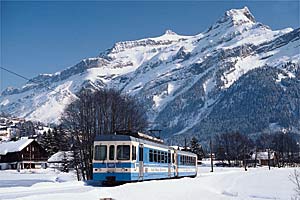All Aboard: Riding the Rails

The Swiss railroads built Swiss skiing. In a country half the size of Maine, there are 3,500 miles of rail line. The trains climb the Alps, span the valleys and bore through mountain sides. At Grindelwald, the cog-rail train climbs to a tunnel in the wall of the Eiger, ending at the world’s highest rail station at 11,400 feet. Next door at Wengen, home of the Lauberhorn World Cup, there are no automobiles, but there are six funicular railways. There are no cars in Zermatt, which can only be reached by train, and the Gornergrat railway, built in 1898, climbs to 10,166 feet, transporting skiers to slopes with perfect views of the Matterhorn.
So dependent are the Swiss on their rails that in the early part of the 20th century they disassembled steel bridges in avalanche zones in the autumn and reassembled them in the spring. Now, 300 miles of avalanche fences guard the tracks. The Glacier Express, from St. Moritz to Zermatt is about a seven-hour journey across 291 bridges, through 91 tunnels¿a moving window on the most dramatic scenery in the Alps. The Bernina Express is so beautiful that many make a day’s outing of a round-trip from Chur or St. Moritz, across the Bernina Pass and down to Tirano in Italy.
You feel the impact of the world’s finest rail system before you even arrive. When you fly Swissair into Geneva or Zurich from a U.S. airport, you can check your skis and luggage for $15 per bag at departure and your gear will meet you at your resort. Returning to the States, you check your baggage the night before your flight and receive your airline boarding pass and seat assignment.
Trains run hourly to and from most Swiss towns. The trains are immaculate and operate as efficiently as a Swiss watch. When changing trains, you may have only two minutes if your connection is departing from the adjoining track, eight minutes if you have to go to another track. Know that Nach means “to” and Zum means “from.” The rest is easy.
Switzerland is a crossroad for European commerce, and the government and railroads are investing millions to free Swiss highways of polluting trailer-trucks. Almost all Swissrail trains are electric. The Vereina Tunnel, opened in November 1999, is part of this plan. For skiers, hikers and tourists, it cuts the time between two great areas in the Alps, the Engadine and the Prattigau, to 90 minutes. Trains leave St. Moritz for Klosters/Davos every hour.
The Swiss Card is the best bet of the many Swissrail passes for anyone staying in Klosters, Davos, St. Moritz or Pontresina and making day trips to other resorts through the Vereina Tunnel. The pass is good for one month and provides round-trip fare from the Zurich airport to your resort and a 50 percent discount on other train travel in Switzerland. A First Class Swiss Card costs $145, a Second Class one, $110. Either class is exceedingly comfortable. You must buy the Swiss Card in the United States. Call Rail Europe at 800-438-7245 or visit www.raileurope.com at least a week before you travel. Your card is sent via Airborne Express.
According to ski-travel expert Chips Lindenmeyr (www.lindenmeyr.com), Swiss skiing is more affordable than it has been in years. A six-day lift ticket in Klosters/Davos, for example, costs $l49-$l86, about half the price of comparable tickets in Vail. Best buys are all-inclusive packages that include airfare, transfers, hotels with breakfast and gourmet dinners, gratuities and ski tickets. Packages for six days of skiing and seven nights in Klosters or St. Moritz, plus an eighth night in Zurich on the way home, range from $1,336 to $2,200 per person. Departures are by Swissair from JFK on Friday nights, returning Sunday afternoon.